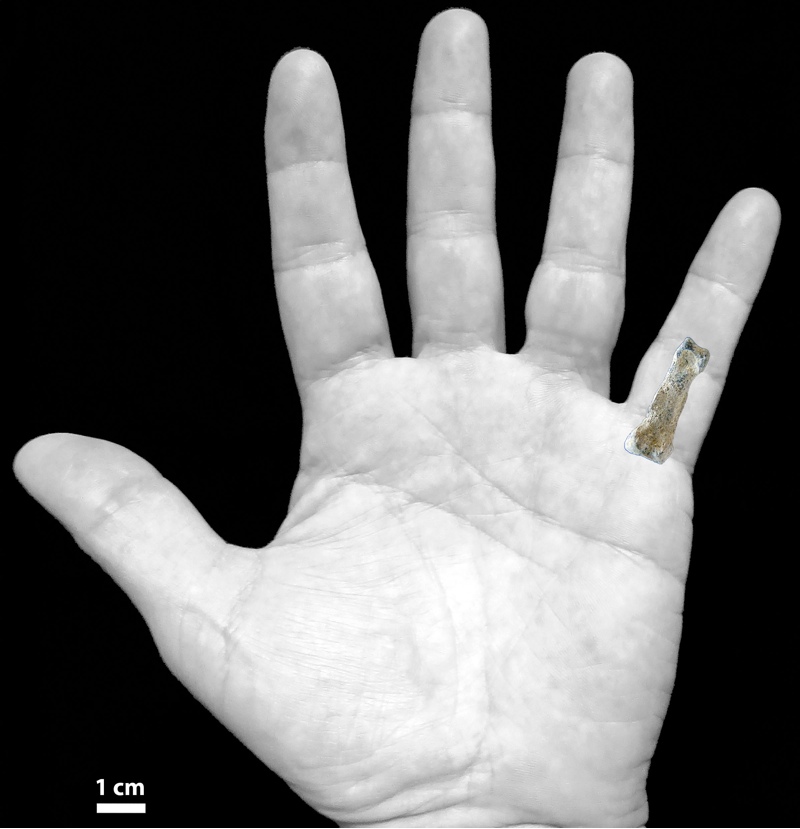Big Human Relative Sported Modern Hands

Scientists have discovered the oldest known fossil of a hand bone to resemble that of a modern human, and they suggest it belonged to an unknown human relative that would have been much taller and larger than any of its contemporaries.
This new finding reveals clues about when modern humanlike hands first began appearing in the fossil record, and suggests that ancient human relatives may have been larger than previously thought, researchers say in a new study.
A key feature that distinguishes humans from all other species alive today is the ability to make and use complex tools. This capability depends not only on the extraordinarily powerful human brain, but also the dexterity of the human hand.
"The hand is one of the most important anatomical features that defines humans," said study lead author Manuel Domínguez-Rodrigo, a paleoanthropologist at Complutense University of Madrid. "Our hand evolved to allow us a variety of grips and enough gripping power to allow us the widest range of manipulation observed in any primate. It is this manipulation capability that interacted with our brains to develop our intelligence." [The 10 Biggest Mysteries of the First Humans]
How the hand evolved
Past analysis of fossils of hominins — the group of species that consists of humans and their relatives after the split from the chimpanzee lineage — has typically suggested that ancient hominins were adapted for a life spent in the trees. For instance, ancient hominin hands often possessed curved finger bones that were well suited for hanging from branches. Modern humans are the only living higher primates to have straight finger bones.
Scientists have often suggested that modern hands evolved to use stone tools. However, recent hominin fossil discoveries have suggested a more complex story behind the evolution of the modern hand. For instance, the hand bones of some ancient hominin lineages are sometimes more similar to modern hands than those of more recent lineages are.
Sign up for the Live Science daily newsletter now
Get the world’s most fascinating discoveries delivered straight to your inbox.
"A modernlike hand in the past would tell us when humans became fully terrestrial and when and how efficiently our ancestors used tools," Domínguez-Rodrigo told Live Science.
To learn more about the evolution of the modern hand, scientists analyzed a newly discovered hand bone dated to more than 1.84 million years ago, dug up from Olduvai Gorge in Tanzania. Previous excavations at Olduvai helped confirm that Africa was the cradle of humanity.
The new bone was probably part of the little finger of the adult left hand of an unidentified hominin lineage similar to Homo erectus, the first hominin known to regularly keep tools it made. The bone is about 1.4 inches (3.6 centimeters) long — "the same size as the equivalent bone in our hand," Domínguez-Rodrigo said. [See Photos of the Oldest Stone Tools]
The straightness and other features of this new bone suggest adaptations for life on the ground rather than in the trees. It adds to previous findings suggesting that several key features of modern human body shape emerged very early in hominin evolution. (This unknown hominin was not, however, a modern human.)
Previous research had suggested that hominins began walking on two legs about 6 million years ago, potentially helping to liberate their hands for tool use. Still, until about 2 million years ago, all known hominin hands showed a double function, allowing hominins to both climb trees and walk on two legs on the ground. (The human lineage Homo is thought to have evolved about 2 million to 3 million years ago; the oldest known extinct human species, Homo habilis, lived at least 1.8 million years ago.)
Before this oldest known hand-bone fossil was discovered, scientists weren't certain when hominin hands began looking like modern hands and became specialized for manipulation. "Our discovery fills a gap — we found out that such a modern-looking hand is at least 1.85 million years old," Domínguez-Rodrigo said.
Big hominin
These findings also reveal that this unknown hominin was larger than other hominins living at the same time or before it. If this newfound finger bone had belonged to a modern human, that person would likely be about 5 feet 9 inches (1.75 meters) tall, Domínguez-Rodrigo said.
"Why is this important? Archaeologists have gathered enough information to understand that early sites like those of Olduvai are central places where hominins repeatedly transported carcasses up to more than 350 kilograms (770 lbs.), which were obtained via hunting," Domínguez-Rodrigo said. "As a specialist on this topic, I always had trouble understanding how Homo habilis, barely taller than 1 meter (3.3 feet), could efficiently hunt animals that big."
"Now, the new discovery shows that a bigger and more modern-looking creature existed at the time these sites were formed," he added. "This makes this creature a better candidate to explain the creation of these early archaeological sites."
The scientists detailed their findings online Aug. 18 in the journal Nature Communications.
Follow Live Science @livescience, Facebook & Google+. Original article on Live Science.










